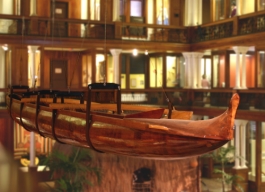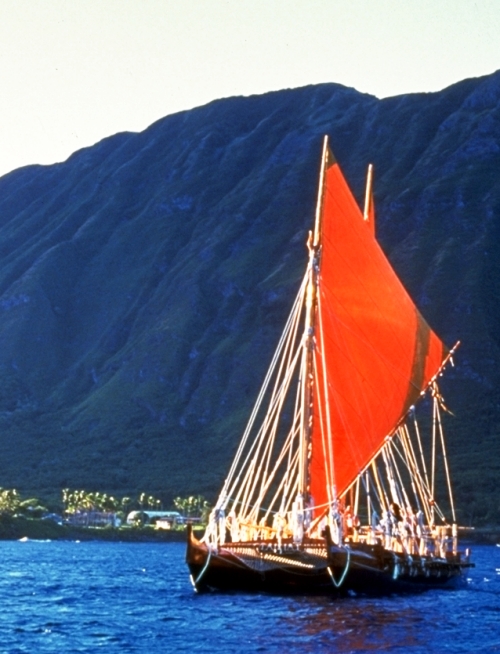Support online education by becoming a member today!
Menu

Ka‘ahumanu was born of sacred rank. She was the hiapo (first born) of the high ranking ali‘i Ke‘eaumoku and Namahana. She linked strong Hawai‘i island and Māui lineages. She was born in a cave at the fortress hill of Ka‘uiki in Hāna, Māui and given a name to honor her glorious ancestor Kahekilinui‘ahumanu. From birth, it was expected that this noble wahine would have a great affect on the kingdom and her marriage as favored wife to the conqueror Kamehameha was to assist in bringing about this destiny. A strong willed and intelligent woman, she would take charge at the death of her husband in 1819 and use her position to eliminate the ‘Aikapu, order the destruction of heiau, and pave the way for a powerful new religion that was to arrive only months later with the coming of the missionaries to Hawai‘i.
Much was changing at this time in Hawai‘i. European and American traders, whalers, and adventurous capitalists came to seek their fortunes in Hawai‘i. They took advantage of a new market hungry for exotic foreign goods, as well as an abundance of valuable Hawaiian resources and cheaply paid Hawaiian labor. Along with a new system of economics, these foreigners brought epidemic disease that devastated the Hawaiian population. Thousands upon thousands of Hawaiians died from Asiatic cholera, measles, the bubonic plague, and other illnesses, decreasing the population of Hawaiians dramatically from an estimated 800,000 at the time of Cook’s arrival to less than 150,000 by 1832. Not only were Kānaka Maoli dying in mass, but the diseases also brought infertility, hindering the birth of a new generation of Hawaiians.
Arriving slightly later than the mercantilists were Protestant missionaries from Boston. When they landed in Hawai‘i in 1820, they came upon a society in which the ruling Kuhina Nui, Ka‘ahumanu, had recently abolished the ‘Aikapu system that dictated the religious, social, and political laws of kingdom. These Protestants were in a unique historical position to influence the very core of Hawaiian society. They quickly realized that success among the masses meant first converting the powerful ali‘i wahine (women rulers). Ka‘ahumanu’s conversion in 1825 and Keōpūolani’s after, meant that the mission now had important allies and access to power.
Ka‘ahumanu’s Bible is an example of the kind of multifaceted changes and influence that the missionaries and other foreign settlers had on the structure of Hawaiian government, society, and religion. A large two-volume book printed in London in 1817 and gifted to the high chiefess Ka‘ahumanu, it is a prime example of the attempts made to convert the Ali‘i class to Christianity. These Protestants quickly became the new “kahuna;” spiritual and political advisors to the high chiefs. They affected change in Hawaiian law to fit Christian doctrine, and made ‘Ōlelo Hawai‘i into a written language so that the Bible could be imparted to the masses. Missionary schools were opened throughout the islands, accelerating Christian conversion rates and teaching Hawaiians to abandon their own culture for “civilized” Western ways.
Even in this time of great outside influence, Native practices and culture did endure. Hawaiians became adept at indigenizing foreign musical instruments, foods, and political structures. When the written word was introduced to Hawai‘i, Kānaka Maoli learned quickly and extensively, making Hawai‘i one of the most literate nations in the world. They adapted to new media technology, publishing their own writings and histories in newspapers run by Kānaka Maoli at astounding rates.
Location: Bishop Museum Library
Call Number: BS 185 L84 1817 l.c. vol. 1

Image from Bishop Museum Archives, Honolulu, Hawaii. Images are not to be re-used without permission.
Prince Jonah Kūhiō Kalaniana‘ole, Hawai‘i.
Call Number: People. Kalaniana‘ole, 1894-1922, folder 3.

Image from Bishop Museum Archives, Honolulu, Hawaii. Images are not to be re-used without permission.
Graphite, ink, wash and watercolor drawing by John Webber, ca. 1778.
As the official artist aboard Captain James Cook’s third voyage through the Pacific (1776-1780), it was John Webber who visually defined for much of eighteenth-century Europe what the distant and exotic peoples and places of this relatively unknown world were like. His commission on this voyage was defined as ethnographic. His work served as a visual history to accompany the written accounts of Cook and his crew. Webber recorded landscapes, scenery, initial contact and other important aspects of society. These images offer a very rare glimpse at life prior to the swift and dramatic changes that would come soon after. The publication and marketing of these well-recorded voyages in the 1785 titled A Voyage to the Pacific Ocean, undertaken by the Command of His Majesty, for making discoveries in the Northern Hemisphere spurred great interest in this part of the globe.
Webber was not only a skilled artist, but also a prolific one. When he returned to England in 1780, he displayed over two hundred sketches made from the voyage. His initial work was developed, by himself and others, into finished engravings. These were published along with the official journals of Captain Cook in 1784. The death of Cook on the final voyage would only intensify interest in the expedition and Webber’s depictions. His work aboard Cook’s ships would eventually earn him a place in the prestigious Royal Academy, which was patronized by King George III.
Webber’s sketches while in Hawai‘i are invaluable as rare looks into early Hawaiian life, it is essential to remember that his representations were created through a lens that carried inherent ideas and understandings of an eighteenth-century European worldview. Webber’s art training prepared him to draw the European body and character. This specific view greatly shaped the way in which he drew Hawaiians. Webber was truly imaging the “other.” Also, both the written and sketched accounts of the voyage were affected by political concerns in Europe at the time. Many of the most commonly seen images that came to represent early Hawai‘i, are indeed second and third generation “workings” of his initial drawings. The sketches and watercolors that Webber created during the voyage were later adapted by engravers and others. These usually better known “finished products” were often significantly different than the original drawings.
This watercolor from the Bishop Museum Art Collection was sketched from a scene that Webber witnessed at Kealakekua Bay, on the western side of the Big Island of Hawai‘i. A double-hulled canoe appeared at Kealakekua where Cook’s ships had anchored. Aboard the canoe are 12 masked rowers, one of whom appears to be carrying a feathered ki‘i, or image. The rowers paddled by the European vessels and continued on to shore with no explanation as to their mission.
Collection: Art Collection
Call Number: Art. E.C. Hawaiian. Transportation. Canoes.
Artifact Number: SXC 96640
Location: Bishop Museum Archives

Image from Bishop Museum Archives, Honolulu, Hawaii. Images are not to be re-used without permission.
In 1973 the Polynesian Voyaging Society was founded. Its mission was to build a double hulled canoe and “retrace the legendary voyages that once linked those far-flung islands and in doing so demonstrate to skeptics that the ancient Polynesians could have intentionally sailed across vast stretches of the Pacific without navigational instruments when most seafaring peoples were still hugging continental shores.”* Indeed while Kānaka Maoli held many oral traditions of great navigators such as Mo‘ikeha, Pa‘ao and Hawai‘iloa, who navigated these seas centuries prior to Captain Cook’s arrival, many others believed that the Polynesians possessed no such great skill and merely drifted to Hawai‘i on an accidental voyage. This “drift” theory not only stole a history of skilled navigation from Hawaiians, but also worked to create a disconnect between a people and their sacred stories.
The P.V.S. completed its first canoe, Hōkūle‘a (star of gladness), in 1975, and with the help of master navigator Mau Pialug of Satawal, sailed on May 1, 1976 from Honolua Bay, Māui. The crew navigated without modern instruments and arrived to a cheering crowd of thousands thirty-four days later in Tahiti. This voyage of way-finding, not only made a statement about a legacy of skilled navigation for Hawaiians but re-awakened a pride within many Kānaka Maoli that helped drive what has been called a “Hawaiian Renaissance.”
The re-birth of traditional navigation, like farming lo‘i (kalo patches), working the loko i‘a (fishponds) and other traditional practices, also helped to re-connect Kānaka Maoli to ancient epistemologies. These traditional ways of knowing contained thousands of years of accumulated knowledge possessed by their ancestors. Learning navigation also brought insights into ‘ōlelo (language), lā‘au (medicine), ho‘omana (religion) and so much more. A better navigator was a better parent, a better co-worker, and better citizen.
The Hōkūle‘a was based on what was known of ancient voyaging design. Limited knowledge about the skills necessary to construct ancient cordage, sails and other parts however, meant that the canoe also contained many modern materials. The second voyaging canoe built by the society, named Hawai‘iloa, was an attempt to use traditional materials as much as possible. One stumbling block was the inability to find a koa log large enough to build the canoe. Where earlier great fleets were built out of native hardwoods, now, after decades of forestry and cattle grazing, trees like the koa were rare. The amazing breadth of the efforts to reclaim ancient knowledges was made apparent when a group of Native Alaskan tribes stepped forward and donated to the society two beautiful Sitka Spruce logs. In an eloquent explanation of the connection between these two distant peoples, a leader of the Alaskan tribe said, “Both the reality and the symbolism of the [Hawai’iloa] project breathe hope and inspiration into all peoples seeking to maintain their traditions, heritage and culture in a society that does not place a high priority on such things….You do it for the Hawaiian people, but it reaches far beyond. In your canoe you carry all of us who share your vision and aspiration for a people to live and prosper with their future firmly built on the knowledge of their heritage and tradition.”**
*Mission: Polynesian Voyaging Society. P.V.S. Pier 7. Honolulu HI.
**Maillot, Byron. CEO, SeAlaska. Building Hawaiiloa. 1993. P.V.S. Honolulu.

Image from Bishop Museum Archives, Honolulu, Hawaii. Images are not to be re-used without permission.
Hawaiian men with canoes at Waikīkī, Hawai‘i. ca. 1900.
Call Number: E.C. Hawaiian. Transportation. Canoes, folder 1.
Artifact Number: SP 203513

Image from Bishop Museum Archives, Honolulu, Hawaii. Images are not to be re-used without permission.
Hawaiian Outrigger Canoe, ca. 1912.
Call Number: E.C. Hawaiian. Transportation. Canoes, folder 1.
Artifact Number: SP 97018

Image from Bishop Museum Archives, Honolulu, Hawaii. Images are not to be re-used without permission.
Kalaniopu‘u bringing presents to [Captain] Cook by John Webber, 1784.
Collection: Art Collection
Call Number: Art. Ethnic Culture. Hawaiian. Transportation. Canoes.
Artifact Number: SXC 96641
Accession Number: 1922.129